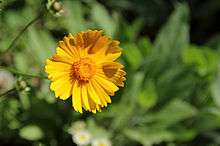Coreopsis lanceolata
| Coreopsis lanceolata | |
|---|---|
| | |
| Coreopsis lanceolata 'Sterntaler' | |
| Scientific classification | |
| Kingdom: | Plantae |
| (unranked): | Angiosperms |
| (unranked): | Eudicots |
| (unranked): | Asterids |
| Order: | Asterales |
| Family: | Asteraceae |
| Genus: | Coreopsis |
| Species: | C. lanceolata |
| Binomial name | |
| Coreopsis lanceolata L. | |
| Synonyms[1] | |
| |
Coreopsis lanceolata, the Lance-leaved coreopsis, is a North American species of Tickseed in the sunflower family. It is apparently native to the eastern and central parts of the United States and naturalized in Canada, the western United States, Mesoamerica, South America, South Africa, and eastern Asia.[2][3][4][5][6]
Description

Coreopsis lanceolata is a perennial plant sometimes attaining a height of over 60 cm (2 feet). The plant produces yellow flower heads in late summer, each head containing both ray florets and disc florets. The plant is useful for pollinator restoration in large urban cities for providing a food source for wildlife as they tend to drink the nectar and/or eat the seed. The plant should not be over watered as it will flop over. Honeybees and butterflies are attracted to this plant and it may be restricted by growing in containers or in lawns that tend to be mowed. [7]
As an invasive plant
Introduced to Japan and China as an ornamental species and later used extensively in greenification projects, particularly along river banks and railways, Coreopsis lanceolata is now known to be outcompeting native plant life and has since 2006 been labeled an invasive species by the Invasive Alien Species Act. The cultivation, transplantation, sale, or purchase of Coreopsis lanceolata is now prohibited and the plant has become the subject of a nationwide destruction campaign, even earning a spot on the Ecological Society of Japan's 100 Worst Invasive Species list.[3][8][9][10]
References
- ↑ The Plant List, Coreopsis lanceolata L.
- ↑ Biota of North America Program 2014 county distribution map
- 1 2 Flora of China, 剑叶金鸡菊 jian ye jin ji ju, Coreopsis lanceolata Linnaeus
- ↑ Berendsohn, W.G. & A.E. Araniva de González. 1989. Listado básico de la Flora Salvadorensis: Dicotyledonae, Sympetalae (pro parte): Labiatae, Bignoniaceae, Acanthaceae, Pedaliaceae, Martyniaceae, Gesneriaceae, Compositae. Cuscatlania 1(3): 290–1–290–13
- ↑ Gibbs Russell, G. E., W. G. M. Welman, E. Retief, K. L. Immelman, G. Germishuizen, B. J. Pienaar, M. Van Wyk & A. Nicholas. 1987. List of species of southern African plants. Memoirs of the Botanical Survey of South Africa 2(1–2): 1–152(pt. 1), 1–270(pt. 2).
- ↑ Forzza, R. C. 2010. Lista de espécies Flora do Brasil. Jardim Botânico do Rio de Janeiro, Rio de Janeiro. Archived September 6, 2015, at the Wayback Machine.
- ↑ Flora of North America, Coreopsis lanceolata Linnaeus, Sp. Pl. 2: 908. 1753.
- ↑ 多紀保彦(監修) 財団法人ja:自然環境研究センター(編著) (2008-04-21). 決定版 日本の外来生物. ja:平凡社. ISBN 978-4-582-54241-7.
- ↑ 畠瀬頼子 (2009-02-28). "オオキンケイギク(Coreopsis lanceolata L.)(緑化植物ど・こ・ま・で・き・わ・め・る)". 日本緑化工学会誌. 日本緑化工学会. 34 (3).
- ↑ 畠瀬頼子・小栗ひとみ・松江正彦 (2008). "木曽川中流域における植生変遷と特定外来生物オオキンケイギクの分布特性". ランドスケープ研究. 71 (5): 553–556.
External links
![]() Media related to Coreopsis lanceolata at Wikimedia Commons
Media related to Coreopsis lanceolata at Wikimedia Commons
- United States Department of Agriculture information and pictures — Coreopsis lanceolata
- Bioimages, Vanderbilt University photos + drawings
- Jepson Manual Treatment: Coreopsis lanceolata